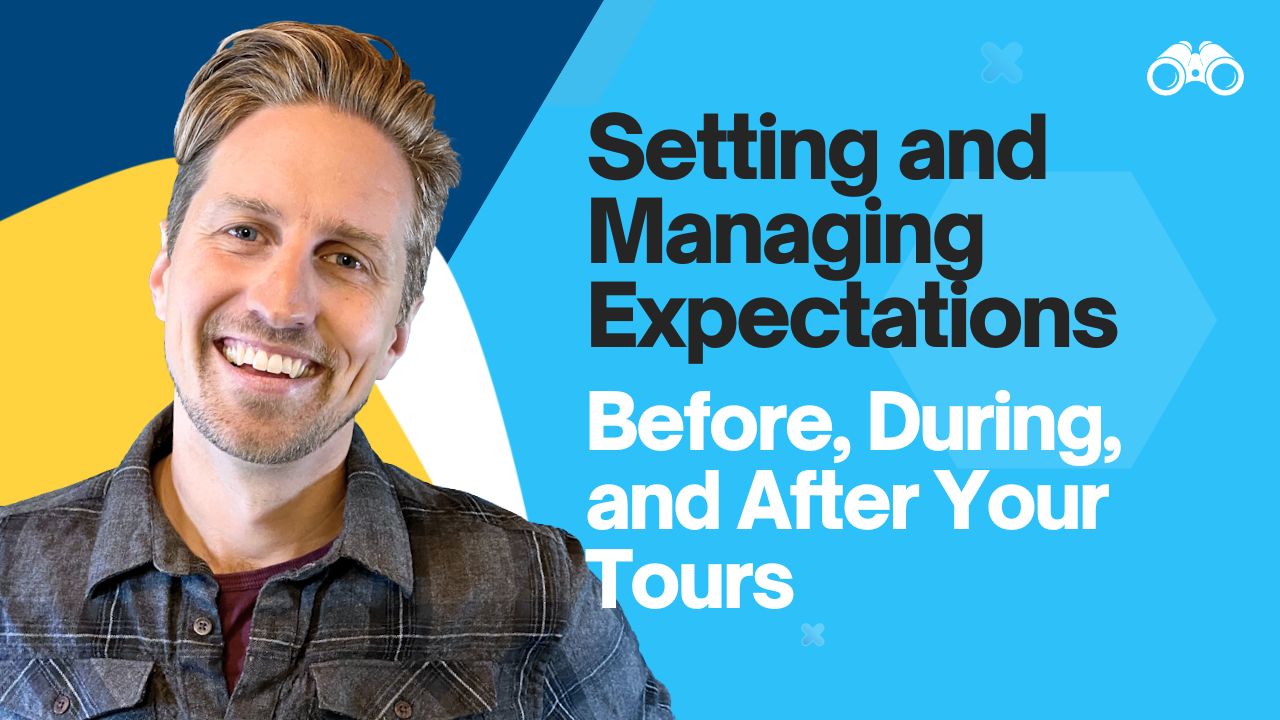The Art of Setting and Managing Guest Expectations for Unforgettable Tours
A five-star review and a one-star review can describe the exact same tour experience. The difference often has nothing to do with what actually happened—but everything to do with what guests expected to happen.
Setting and managing expectations might be the most underrated skill in the tour business. It’s not flashy or exciting, but it’s the foundation that makes or breaks the guest experience. When expectations are properly managed, even tours with hiccups can feel like successes. When they’re not, even the most meticulously planned experiences can disappoint.
The Three Types of Guest Expectations
Your guests arrive with three different types of expectations that you need to understand and manage:
1. What You Explicitly Promised
These are the expectations you create through your website, sales pages, and pre-trip information. When you showcase specific experiences, promise certain outcomes, or highlight particular features in your marketing materials, you’re creating explicit promises that guests will expect you to fulfill.
2. What Guests Assume is Standard
These expectations aren’t directly in your control but come from what guests assume is normal for your type of tour. Maybe your competitors all offer something you don’t. Perhaps there’s new technology that guests now consider standard.
For example, if every tour company in your area sends SMS messages with Google Maps links to the meeting point, and yours doesn’t, guests may feel something is missing—even if you never promised this service.
Previous online reviews also set expectations. If a past review mentions something special that happened (even if it was a one-time occurrence or only done by certain guides), future guests might arrive expecting the same treatment.
3. Personal Promises Made During Tours
These are commitments made by your staff, team members, or tour leaders. Even casual comments like “We might stop for gelato if we have time” can be interpreted as promises. It’s crucial that your team follows through on whatever they say they’ll do.
Managing Expectations Throughout the Customer Journey
Sales Pages and Tour Descriptions
Be as accurate as possible in your descriptions. If you make promises about what people will experience, you must follow through. That said, you should leave room for some surprises. If you detail every single element of your tour, you limit your ability to wow and delight guests with unexpected special moments.
Your FAQ section is hugely important—not just for overcoming sales objections but for setting clear expectations about what you can and cannot accommodate.
A best practice that many tour operators miss: Use your sales pages in the training of your tour leaders and activity hosts. Make sure they know exactly what guests have been told to expect.
Marketing Materials
Your marketing should get people excited without over-promising. Yes, you want to explain why your tour is the best option in your destination, but remember that every claim in your marketing materials sets expectations for future guests.
Confirmation Emails and Receipts
These should include essential meeting information, packing lists, and what to expect. They’re also an overlooked opportunity to create a personal connection with your brand and get people excited about the upcoming experience.
Consider recording a short video from you as the founder or from key team members saying: “Thanks so much for booking this tour. We’re really excited to welcome you. Below is information to ensure you come prepared and have the best time possible. We’ll see you soon!”
This personal touch builds trust and rapport, making your brand more memorable and increasing the likelihood of referrals.
Reminder Emails and Messages
As the tour approaches, reminder emails and texts provide another chance to build excitement and manage expectations. These communications should:
- Reconfirm key details
- Address common concerns
- Share best practices or recommendations
- Set guests up for success
Many tour companies don’t customize these messages when using booking software. Others worry about repeating information. But remember—many guests won’t fully read your sales pages, FAQs, or confirmation emails. Every communication is another opportunity to set proper expectations.
When the tour begins, assume people haven’t seen any pre-trip information. Make sure to set expectations clearly in the first five minutes of your experience.
Preparing for When Things Go Wrong
Meeting expectations also means knowing what to do when things don’t go as planned. Have clear policies and make sure every team member knows exactly what to do in common scenarios:
- What happens if guests are late?
- What if someone gets lost?
- What if someone is injured?
- What if there’s a vehicle accident?
- What if weather issues disrupt your plans?
- How do you handle emergency situations or itinerary changes?
- How do you remove a disruptive person without ruining the experience for everyone else?
Much of this comes down to preparation and training. Don’t leave anything to chance. Be explicit with your guides about expectations for their personal appearance, hygiene, and professionalism.
Don’t Shy Away from Qualification and Straight Talk
Qualification means laying out plain requirements for your tour. For a multi-day tour with hiking elements, be clear about the required fitness level and terrain challenges. If part of your experience involves uneven ground or cobblestones, say so upfront.
Having people on tours they shouldn’t be on creates problems for everyone—the guests themselves, your guides, and other participants. It’s in everyone’s best interest to be explicit about any limitations.
“Straight talk” means being upfront about potential unpleasantries. If someone books an August tour in Rome, crowds and heat will be part of their experience. Set that expectation. Explain how you manage these challenges, but be honest that they exist.
Building on a Solid Foundation
Over the years, we’ve been exposed to countless inspiring ways tour operators wow and delight their guests. But all those special moments only work when built on the rock-solid foundation of well-managed expectations.
As we’ve explored in our training series on creating unforgettable experiences, many elements contribute to memorable tours:
- Guest-focused design
- The unforgettable product pyramid
- Special moments, people, and access
- Storytelling and tour themes
- Engaging all senses
- Interactive elements that create engagement
- Perfect flow with strong first impressions and endings
- Personalization opportunities
All of these elements work together to create experiences guests will never forget. But they only succeed when built on that critical foundation—well-managed expectations.
When guests know what to expect and you deliver on those promises (and ideally exceed them in ways they didn’t anticipate), you’ve created the perfect recipe for unforgettable tours and five-star reviews.
Want help creating more engagement (and stellar reviews) for your tours? Book a free 45-minute strategy call with us today!




